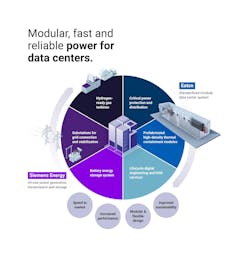Siemens Energy-Eaton and Compu Dynamics Redefine Modular Infrastructure for AI and HPC Workloads
As the AI boom accelerates, the definition of "modular" infrastructure is rapidly evolving. Suffice to say the term is longer confined to simple containers or bolt-on power kits. Instead, it's emerged as a strategic design principle underpinning the next generation of AI and HPC-ready data centers. Whether focused on grid-independent power generation or prefabricated compute blocks, modularity now means speed, scalability, and the ability to bypass traditional bottlenecks.
Twin recent announcements from Eaton–Siemens Energy and Compu Dynamics Modular illustrate two powerful, complementary visions for how modular infrastructure can meet the demands of an AI-defined future.
Eaton and Siemens Energy Partner to Fast-Track Modular Data Center Development with Integrated Onsite Power
In a strategic response to the growing strain on grid infrastructure and the ballooning power demands of AI-driven digital infrastructure, Eaton and Siemens Energy have announced a joint initiative designed to rapidly accelerate data center deployment. Their integrated offering combines modular data center construction with grid-independent power generation: a critical step for a market increasingly defined by latency-sensitive workloads, stranded sites, and hyperscale ambitions.
The collaboration, revealed today in Berlin and Bonn, targets one of the most urgent bottlenecks in the global data center buildout: energy availability. In an era when artificial intelligence models are driving exponential compute requirements -- and with data center electricity demand forecasted to double to 945 terawatt-hours by 2030 (roughly equivalent to Japan’s total energy use) -- traditional timelines for grid interconnection are falling dangerously out of sync with digital infrastructure timelines.
New Power Paradigm: Standardized, Scalable, and Grid-Optional
At the heart of the Eaton–Siemens Energy solution is a modular power architecture designed to decouple data center construction from grid delays. Siemens Energy’s baseline configuration features a 500 MW onsite power plant built around the company’s high-efficiency SGT-800 gas turbines, supported by redundancy, battery storage, and options for future hydrogen integration.
“We offer hyperscalers, co-locators and investors a unique package, enabling them to reduce the time-to-market by up to two years in many places, which leads to significant revenue gains,” said Andreas Pistauer, Global Head of Sales for Siemens Energy’s Gas Services Business Area. “Our power plant design is built with redundancy, eliminating the need for backup diesel generators, and reducing CO₂ emissions by about 50 percent.”
This configuration supports a range of deployment scenarios—particularly in regions where power infrastructure lags behind land availability. The Siemens Energy system can optionally include a clean-air grid connection, allowing data centers to support grid services and decarbonization efforts when regulations permit.
Eaton Brings Modular Electrical Backbone and Software Stack
Complementing Siemens Energy’s generation infrastructure, Eaton will deliver the electrical distribution and digital backbone required to bring data center workloads online fast. The company's scope includes medium- and low-voltage switchgear, UPS, busways, structural support systems, and the engineering services needed to integrate everything from medium-voltage grid to chip assets.
Cyrille Brisson, Eaton’s Global Segment Leader for Data Centers, emphasized the flexibility of the approach: “Our method lets customers choose the right energy mix, and construction-to-startup time is swift, with both short- and long-term emissions reduction options. Most importantly, we’re enabling developers to go live wherever they have land access to gas, water, and fiber.”
Brisson’s mention of proximity to utilities (especially gas) highlights an emerging trend in hyperscale planning: the move toward brownfield or remote sites with available fuel infrastructure but limited or delayed grid capacity. This model dovetails with a growing wave of stranded power strategies, modular site design, and onsite generation investment across North America, Europe, and the Middle East.
Why This Matters Now: AI and Grid Headwinds Collide
The Eaton–Siemens Energy announcement lands amid an inflection point in data center development strategy. AI training clusters, inference farms, and general cloud growth are driving unprecedented pressure on utility providers. At the same time, grid interconnection timelines in North America, Germany, and parts of Asia can stretch from two to seven years. This mismatch is beginning to realign how hyperscalers and colocation providers approach site selection and energy procurement.
Several recent moves point to a broader market shift toward self-generation. Microsoft, Amazon, and Google have ramped investments in natural gas and backup generation assets. DigitalBridge and Equinix are exploring edge-adjacent gas generation. Startups like Vaire Computing and Infrastructure as Code (IaC) players are also eyeing integrated compute-and-power approaches.
This isn't just about getting power faster. It appears to be about architecting resiliency, scalability, and compliance into data center energy strategy from day one. Could this collaboration be further evidence the market is moving beyond backup power to thinking like a utility?
The Bigger Picture: Modular, Repeatable, and Emissions-Conscious
The scalability and repeatability of this new approach appear tailored for hyperscalers with global portfolios and colocation players navigating edge expansions. Both Eaton and Siemens Energy emphasize the modularity of their systems as key to replicability across regions, critical for meeting AI-era timelines.
While the standard configuration emphasizes natural gas, Siemens Energy’s roadmap includes hydrogen-readiness and options to retrofit emissions-free grid connections. That roadmap aligns with increasing regulatory pressure in Europe and parts of North America to reduce diesel reliance and phase in clean energy sources without compromising uptime.
Modular Momentum Builds: Compu Dynamics Modular Launches with Fully Integrated, High-Density Solutions
And so the modular data center space, long seen as a niche offshoot of traditional construction, continues its transformation into a central delivery mechanism for AI-era infrastructure. Nearly contiguous with Eaton and Siemens Energy announcing a strategic alliance to accelerate onsite-powered data center deployment, Compu Dynamics has launched Compu Dynamics Modular (CDM), a standalone business unit focused entirely on fully prefabricated, high-performance modular solutions.
While both announcements center on “modular” solutions, the term of course carries distinct meanings in each context. For Siemens Energy and Eaton, modularity refers primarily to standardized, skidded onsite power generation systems that can be scaled and deployed in parallel with data center construction -- an energy-first approach to modular infrastructure.
Prefab for the Win
In contrast, Compu Dynamics Modular (CDM) applies modularity to the physical data center itself: fully prefabricated, high-density digital infrastructure engineered and assembled offsite. Both strategies reflect a shared industry imperative: to compress deployment timelines and decouple infrastructure buildouts from legacy dependencies. But they attack the problem from different angles: one from the grid inward, the other from the rack outward.
Based in Chantilly, Virginia, CDM debuts with a compelling proposition: turnkey, vendor-neutral modules engineered to support AI training clusters, HPC workloads, GPU farms, and next-generation edge inference systems. More than portable white space, each CDM module is a self-contained data center ecosystem, factory-integrated with mechanical, electrical, and liquid cooling infrastructure.
“We are not building containers — we are delivering high-performance, factory-integrated data center solutions that are fully operational from day one,” said Ron Mann, Vice President of Compu Dynamics Modular. That distinction is critical in a market that now values repeatability, power density, and time-to-value above all else.
Whereas legacy modular solutions often served as stopgaps or remote outposts, CDM’s approach is firmly forward-looking. It aligns with the needs of neocloud operators, AI-native startups, and OEMs embedding compute clusters directly into data center blocks. The company provides end-to-end lifecycle support, from engineering and fabrication through commissioning and long-term maintenance.
Steve Altizer, President and CEO of Compu Dynamics, described the launch as a natural evolution of the company’s decades-long experience in traditional data center infrastructure: “CDM is built to meet the modular demands of tomorrow’s compute landscape, where speed-to-market, flexibility, and high-density performance are critical. It reflects our belief that modular is not an afterthought; it’s a strategic advantage.”
CDM’s solutions are purpose-built for liquid-cooled architectures, variable power densities, and rapid deployment cycles—meeting the same constraints that are increasingly defining data center site viability and capital investment decisions. With a focus on deployment-ready performance, each module undergoes full Factory Acceptance Testing (FAT) before shipment, enabling site commissioning in days, not months.
This level of integration and reliability also makes CDM an attractive partner for hyperscalers targeting stranded capacity opportunities or launching regional expansions where grid upgrades lag behind compute demand.
Conclusion: A New Era for Modular, Powered, and AI-Ready Data Centers
Taken together, the announcements from Eaton, Siemens Energy, and Compu Dynamics Modular reflect a broader architectural shift in how digital infrastructure is designed, delivered, and energized.
As AI drives the need for denser, more distributed, and more energy-resilient facilities, the industry is no longer viewing modular as an experimental edge use case: it is now a primary vehicle for delivering scale at speed. And crucially, from integrated power plants that eliminate diesel generators to prefabricated modules designed to support liquid-cooled superclusters, the new generation of modular infrastructure is more than just fast: it's strategically aligned with the power, cooling, and latency constraints of tomorrow’s workloads.
It seems clear that the age of AI demands data centers that are not only smarter and faster, but which are ready-to-run on day one, wherever the opportunity arises. In this new model, infrastructure is not just constructed; it's being orchestrated, from chip to grid to workload, with energy and performance engineered in from the outset.
At Data Center Frontier, we talk the industry talk and walk the industry walk. In that spirit, DCF Staff members may occasionally use AI tools to assist with content. Elements of this article were created with help from OpenAI's GPT4.
Keep pace with the fast-moving world of data centers and cloud computing by connecting with Data Center Frontier on LinkedIn, following us on X/Twitter and Facebook, as well as on BlueSky, and signing up for our weekly newsletters using the form below.
About the Author
Matt Vincent
A B2B technology journalist and editor with more than two decades of experience, Matt Vincent is Editor in Chief of Data Center Frontier.




